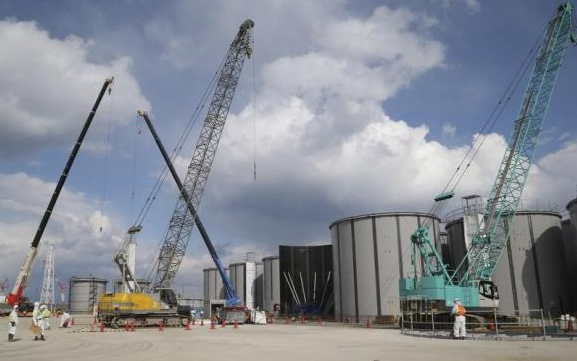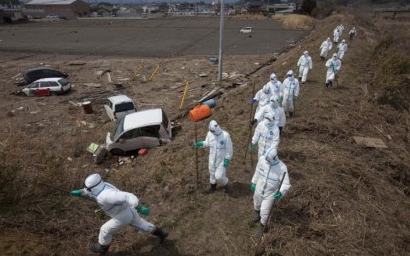
The system built to manage Russia’s nuclear legacy is crumbling, our new report shows
Our op-ed originally appeared in The Moscow Times. For more than three decades, Russia has been burdened with the remains of the Soviet ...
News

Publish date: May 22, 2014
News
Tokyo Electric Power Co (Tepco) has started diverting treated groundwater at the crippled Fukushima Daiichi nuclear power plant into the sea, in an attempt to reduce the massive quantities of radioactive water that accumulating on site since the a triple meltdown in 2011.
The news comes a day after a Japanese newspaper dealt another thrashing blow against public trust in the nuclear industry, detailing that almost all of Fukushima Daiichi’s workers and technicians defied orders and fled their posts in the heat of the meltdowns after an 11-meter tsunami and a 9.0 scale earthquake hit the plant on March 11 of that year.
The controversial release also coincides with a breakdown of a water treatment system for the highly contaminated water held in makeshift tanks.
At a news conference on Wednesday, May 21, Japan’s Chief Cabinet Secretary Yoshihide Suga said the start of the so-called water bypass project represents a “small step” in tackling the buildup of contaminated water, which has been a major source of public concern and an ongoing glitch in efforts to bring the still dangerous plant to heel.
At 10:25 a.m. local time on Wednesday, the utility started releasing about 560 tons of water located in the nuclear power plant compound in April. It took about two hours to release the water, reported Asashi Shimbun newspaper.

The water released into the sea came from storage tanks at locations south of Fukushima Daiichi’s No 1 to No 4 reactor buildings through drainpipes it installed in spring 2013.
Water build-up after the disaster, and ‘embarrassing developments
Since shortly after the accident, 400 tons a day of groundwater have been seeping into contaminated reactor and turbine buildings at the Fukushima Daiichi. Tepco estimates that the groundwater bypass project will reduce the amount of groundwater seepage by 20 to 100 tons per day, Suga told reporters.
Tepco has struggled to contain radioactive water at the plant, which was crippled by the March 2011 earthquake and tsunami.
Water is being used to cool nuclear reactors an vulnerable spent nuclear fuel storage pools since the triple meltdown of the plant’s reactor Nos 1,2 and 3 – but this water then becomes highly radioactive and must be stored.
The groundwater flows from hills around the Fukushima plant. Much of this water has been flowing into the plant, mixing with the cooling water and becoming contaminated.
Workers have been pumping it into storage before it seeps into contaminated areas. Workers have struggled to safely store this water and there have been several leaks at a tank farm erected for the purpose.
In April of 2013, Tepco was forced to admit that as many as 167 tons of water with an estimated radioactivity of 710 billion Becquerel had leaked from one of more than 1000 tanks at the site.

In another of persistent letdowns, however, it was announced on Wednesday that a water treatment facility known as the Advanced Liquid Processing System, designed to remove the most dangerous nuclides, was completely shut down again this week. The system has not been fully operational since it was installed nearly two years ago.
The plants current manager admitted to Reuters that the repeated leaks and equipment malfunctions are “embarrassing.”
Tepco, according to Japanese media, has made no announcement of how long it will have to continue the sea dumps of the treated water.
The new bypass system and what the water contains
Under the new bypass system, groundwater is pumped into the 1000 wells where it is decontaminated before it reaches the plant. It is then released into the sea after radiation levels are checked.
Tepco told reporters the water released into the sea meets strict safety guidelines, surpassing those applied by the World Health Organization, the utility told the BBC.
A statement from Tepco, the Japan Atomic Energy Agency and independent groups found that radioactive elements in the released water have less than 1 Becquerel’s per liter of Cesium-134 and Cesium-137. All other radioactive elements checked are also far below standards for groundwater release.
The legal limit for releasing Cesium-134 into the ocean is 60 Becquerel per liter.
The water dumps were agreed with local fishermen, who have been opposed to any water dumping into the sea, after extended negotiations. Water dumps were seen as early as last September as inevitable by Shunichi Tanaka, chairman of Japan’s newly constituted nuclear watchdog, the Nuclear Regulation Authority.
Tanaka said at the time that, “I’m afraid that it is unavoidable to dump or release the water into the sea” after it is purified to levels recognized as safe under international standards.
On Wednesday, Suga told a press conference that, “It was an agonizing decision for fishermen in the area to endorse the plan.”
“We will have the industry ministry strictly instruct Tepco to abide by its rules on contamination levels of water to be released,” said Suga.
Trusting Tepco?
Tepco, however has a long way to go even three plus years after the world’s most serious nuclear accident since Chernobyl in regaining public trust. Japanese news reports carry nearly weekly descriptions of the Tepco’s near press-ganging of homeless men to work on decontamination efforts in Japan’s still-struggling economic circumstances.

A Reuters investigation published in December found widespread labor abuses, where workers said their pay was skimmed and there was little oversight over working conditions inside the plant. Many of these workers are, reports say, exposed to high levels of radiation, higher than would be allowed for professional nuclear workers.
Further efforts to make their own plight known are further hindered by a new Japanese government law passed earlier this year that severely punishes what it vaguely defines as leaked information from bureaucrats and workers alike.
The law specifically targets government workers leaking sensitive information – and reporters who seek it. Environmentalists have long feared the new law would allow official collusion and corruption of the kind unearthed during the initial disaster at Fukushima Daiichi to flourish, and they are apparently being proved right.
Further distrust spread by revelations of worker flight during the disaster
The water release comes as another black eye was dealt to Japan’s nuclear industry by Asashi Shimbun newspaper, which on May 20 revealed in a report that about 90 percent of workers at the plant fled at the height of the meltdown crisis.
The paper’s report was based on transcripts of interviews previously stored in the prime minister’s office with the plant director, who died last year.
If true, the transcript sharply differs from accounts by Tepco of the early days after the tsunami hit, as the utility reported that workers were told to leave the site.
At the time, Japanese media carried reports of the “Fukushima Fifty,” a group of suicidally heroic workers who demanded to stay at their posts to bring the meltdowns under control.
The viewing of the confidential 400-page debriefing of Fukushima’s former plant manager, Masao Yoshida, by Asashi Shimbun paints a far more shameful story of official deceit and propaganda spun by cooperative media, Japan’s powerful nuclear industry, and Tepco.
Yoshida died of esophageal cancer last year at the age of 58. He, too, was painted as one of the disaster’s early heroes for defying an order to stop pouring seawater on the overheating reactors, though is reputation is deserved. He elected to remain behind at Fukushima Daiichi with 68 other workers, while a remaining 650 workers and midlevel managers fled to another nearby nuclear power plant.
At yesterday’s news conference devoted to the water releases, Suga did not dispute the accuracy of Asashi Shimbun’s report. He said the transcripts of interviews with Yoshida and others involved in the accident had not been disclosed because they were not intended for the public record, though he did not explain why. Suga was reported by the Japan Times on Thursday as saying he would not declassify the records, preventing their evaluation against the newspaper report.
A spokesman for Tepco, Ryo Shimizu, told the New York Times he disputed one crucial aspect of the Asahi Shimbun report, saying that Tepco records showed Yoshida issued a more vaguely worded order to withdraw to “low radiation areas,” a term that could also include the neighboring plant 10 kilometers away. Thus, he said, Tepco did not view the fleeing employees as actually having violated an order.
Reactor restarts prevented by grassroots outcry
Meanwhile, a court in Japan ruled against restarting two nuclear reactors at a plant in Fukui prefecture after anti-nuclear campaigners questioned its safety.

All 50 of Japan’s nuclear reactors are currently undergoing stress tests that last six months each, and are being conducted by teams from the Nuclear Regulatory Authority. Only after plants have passed technical muster from the regulators, which certifies they are capable of withstanding extremely violent natural disasters would they be allowed to come back on line.
But the stress tests are only the first hurdle: Local town and prefecture governments and the public must also agree to allow the idled reactors in their communities to restart – a hard sell to a Japanese public whose trust in the government and nuclear power have plummeted due to the ongoing mishandling of the Fukushima crisis.
The Ohi plant, which will remain offline, was shut down along with Japan’s other nuclear plants after the meltdowns of the Fukushima nuclear reactors.
Japan has since been forced to import huge amounts of coal, liquid natural gas and other fuels, leading to its first series of trade deficits ever, which began in 2011 as resource imports spiked to cover for lost nuclear energy.

Our op-ed originally appeared in The Moscow Times. For more than three decades, Russia has been burdened with the remains of the Soviet ...

The United Nation’s COP30 global climate negotiations in Belém, Brazil ended this weekend with a watered-down resolution that failed to halt deforest...

For more than a week now — beginning September 23 — the Zaporizhzhia Nuclear Power Plant (ZNPP) has remained disconnected from Ukraine’s national pow...

Bellona has taken part in preparing the The World Nuclear Industry Status Report 2025 and will participate in the report’s global launch in Rome on September 22nd.